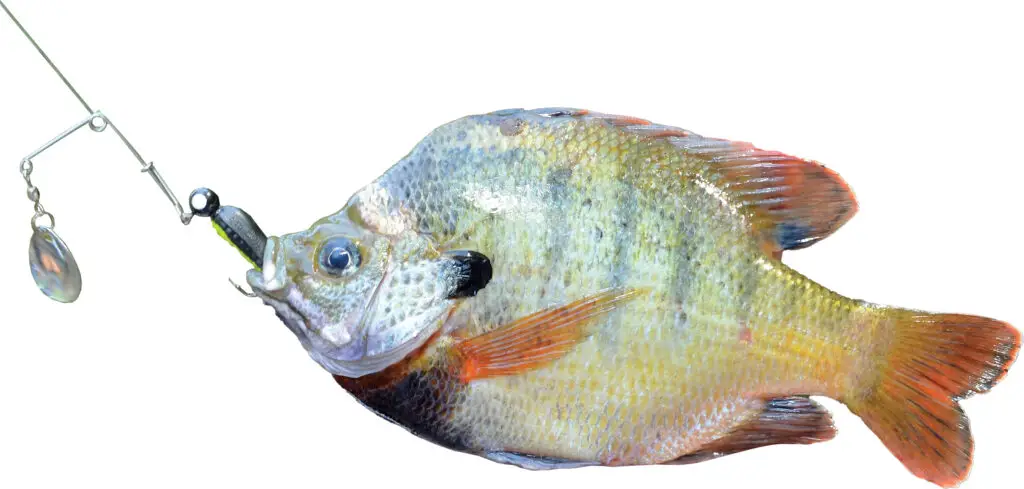Tiny baits produce big action from feisty panfish.

Most sportsmen probably began fishing by dangling worms or crickets under floats to catch bluegills and other assorted bream species. This old method will always work, but for more of a challenge, try casting lures for pugnacious panfish.
Fishing for bream with ultralight tackle greatly resembles downsized bass fishing. With an ultralight spinning reel loaded with 4- to 6-pound-test line, throw various temptations to likely spots to entice something to clobber it. Bluegills, redear sunfish, also called shellcrackers, and other assorted panfish species frequently hit tiny spinners, crankbaits, jerkbaits and even topwater lures.
Among the most versatile lures on the market, spinnerbaits catch multiple fish species from top to bottom all year long and can go many places where other lures can’t go. Spinnerbaits can provoke vicious strikes even from non-aggressive fish that might refuse other offerings. The whirling blades give off vibrations and flash that fish can easily detect.
Many panfish enthusiasts throw “beetle” spinnerbaits, also called “harness” or “jighead” spinners. Such baits consist of a wire harness attached to a jighead. Since the components separate, anglers can easily switch blades, arm sizes, jigheads or soft-plastic trailers as they wish.
On the jighead, anglers can hook an infinite number of trailer combinations in different sizes, shapes, colors and configurations. If fish won’t bite one color or size, try something else. To change trailers, simply thread a new one onto the hook without retying the line attached to the jighead. For added enticement, tip the hook with a colorful scent pellet.
A beetle spinner can catch panfish throughout the entire water column in all seasons. Work beetle spinners several different ways. Retrieval speeds determine how deep the lure runs. Like in bass fishing, simply toss the lure to a sweet spot, such as grassy edges, lily pads, downed trees or other cover that might hold fish and work it back to the boat.
Bluegills spawn from late spring through early fall. They make depressions on the bottom for nests. Spawning beds make great places to throw spinners. Around the beds, let the lure drop to the bottom. Then, slowly work it just over the bottom. Barely turn the reel handle, just enough to make the blades flicker.
Around thick grassy patches, buzz beetles over the top so the blades churn the water or wake the baits just below the surface with steady retrieves. A surface commotion can bring fish up from the depths.
Also try the stop-and-go method. Pause the retrieve periodically to let the bait sink a foot or two. As the bait slowly descends, the blades continue revolving and creating flash and vibrations. Fish commonly hit lures as they sink. This method works great when fishing submerged grass beds. Run the spinner just over the grass tops. Occasionally, stop so the lure sinks into the grass.
As weather warms, fish might head a little deeper for more comfortable temperatures. Sloping banks and drop-offs give fish easy access to both deep and shallow water so they can move up and down in the water column as they desire. Along woody river shorelines, toss beetles near tree trunks, fallen logs, stumps and other cover. Near shorelines, jetties, fallen logs, drop-offs and similar places, work baits parallel to the cover. Bream commonly hover just over the drop-off edge looking to ambush passing prey.
Bridge or dock pilings, standing timber and other structures can provide deep cover from top to bottom. Fish might hold at any depth. On the hottest days, cast to the coolest places, such as under docks, trees, bridges and other places that cast shadows on the water. Also look for small tributaries flowing into larger waterbodies. Flowing water in the shade runs slightly cooler than water in the sunshine.
Around deep cover, try the “yo-yo” or “helicopter” retrieve. Let the bait sink to the bottom and then pull it back up to the surface. Then, let it sink again. In extremely deep water, pop the bait off the bottom and let it sink again. Keep trying different depths and retrieves to see what works best that day.
Easy to master and inexpensive, fishing with small beetle spinners on ultralight tackle offers an excellent and extremely fun way to introduce children or novice anglers to the sport. In the right spot, anybody could catch good numbers of feisty fish. Despite their diminutive size, bluegills and other bream species can outfight anything in fresh water, ounce for ounce.
John N. Felsher is a professional freelance writer who lives in Semmes, Ala. He also hosts an outdoors tips show for WAVH FM Talk 106.5 radio station in Mobile, Ala. Contact him at [email protected] or through Facebook.




